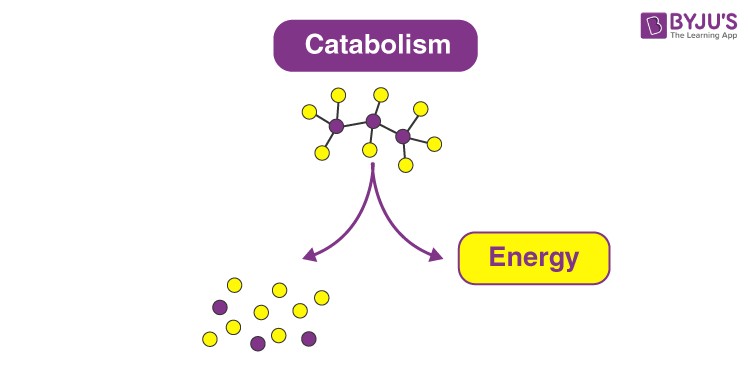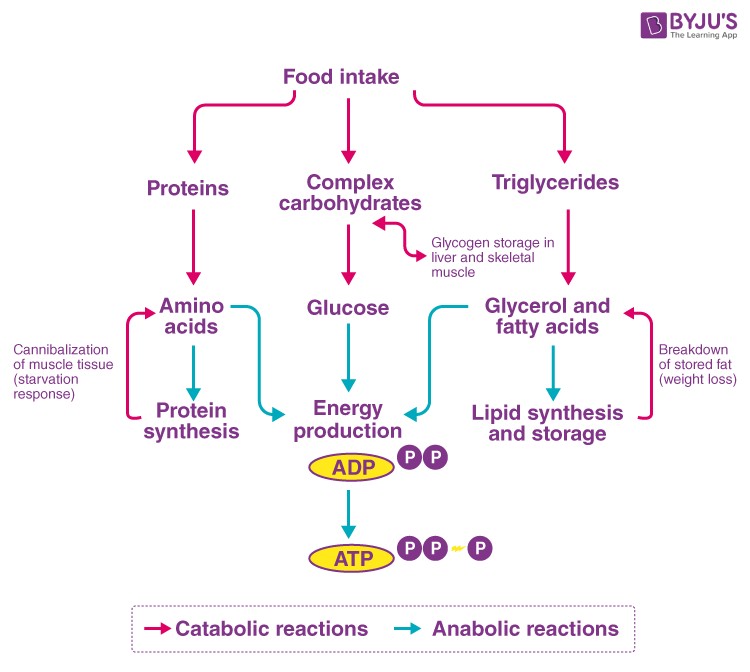Catabolism is the set of metabolic processes that break down complex molecules into simpler ones, releasing energy. At WHAT.EDU.VN, we provide clear, concise explanations of biological processes like catabolism, making learning easy and accessible. Explore the breakdown of molecules and energy production, and discover associated metabolic pathways!
1. What is Catabolism? A Detailed Explanation
Catabolism is a fundamental aspect of metabolism, the intricate network of chemical reactions that occur within living organisms to sustain life. Specifically, catabolism involves the breakdown of complex molecules into simpler ones, a process that releases energy in the form of ATP (adenosine triphosphate) and reducing power. This energy is then utilized for various cellular activities, including anabolism (the synthesis of complex molecules), movement, and maintenance of cellular functions.
Think of catabolism as the “demolition” crew within your cells, dismantling larger structures into smaller, more manageable pieces. This process not only generates energy but also provides the building blocks for creating new molecules and structures through anabolism. The balance between catabolism and anabolism is crucial for maintaining homeostasis, or a stable internal environment, within the organism.
2. The Purpose of Catabolism: Beyond Energy Production
While energy production is a primary function of catabolism, it’s not the only one. Catabolism serves several essential purposes within living organisms:
- Energy Production: As mentioned earlier, catabolism breaks down complex molecules, such as carbohydrates, lipids, and proteins, to release energy in the form of ATP. This ATP is the primary energy currency of the cell, powering various cellular processes.
- Provision of Building Blocks: Catabolism breaks down large molecules into smaller subunits that can be used as building blocks for synthesizing new molecules through anabolism. For example, proteins are broken down into amino acids, which can then be used to synthesize new proteins.
- Waste Removal: Catabolism also plays a role in removing waste products from the cell. By breaking down complex molecules into simpler ones, catabolism helps to eliminate substances that could be harmful or toxic to the cell.
- Nutrient Mobilization: During times of stress or starvation, catabolism can be activated to break down stored nutrients, such as glycogen (stored glucose) and triglycerides (stored fats), to provide energy and building blocks for the cell.
3. The Three Stages of Catabolism: A Step-by-Step Process
Catabolism typically occurs in three main stages:
3.1 Stage 1: Digestion and Hydrolysis
In this initial stage, large complex molecules, such as polysaccharides, lipids, and proteins, are broken down into smaller units through digestion and hydrolysis. This often occurs outside of cells or in specialized compartments within cells, such as lysosomes.
- Polysaccharides are broken down into monosaccharides (simple sugars) like glucose.
- Lipids are broken down into fatty acids and glycerol.
- Proteins are broken down into amino acids.
3.2 Stage 2: Degradation to Simpler Intermediates
The smaller molecules produced in stage 1 are further degraded into simpler intermediates, such as acetyl-CoA, pyruvate, and other small organic molecules. This stage often involves a series of enzymatic reactions that release a small amount of energy.
- Glucose is broken down into pyruvate through a process called glycolysis.
- Fatty acids are broken down into acetyl-CoA through a process called beta-oxidation.
- Amino acids can be converted into various intermediates depending on their structure.
3.3 Stage 3: Oxidation and Energy Release
In the final stage, the simpler intermediates produced in stage 2 are completely oxidized to carbon dioxide and water through a series of reactions known as the citric acid cycle (also called the Krebs cycle) and oxidative phosphorylation. This stage releases a large amount of energy in the form of ATP.
- Acetyl-CoA enters the citric acid cycle, where it is oxidized to carbon dioxide, releasing energy and reducing power in the form of NADH and FADH2.
- NADH and FADH2 donate electrons to the electron transport chain, which drives the synthesis of ATP through oxidative phosphorylation.
4. Key Catabolic Pathways: Glycolysis, Beta-Oxidation, and More
Several important catabolic pathways play a vital role in energy production and metabolism. Here are some key examples:
- Glycolysis: The breakdown of glucose into pyruvate, occurring in the cytoplasm of cells. This process generates a small amount of ATP and NADH.
- Beta-Oxidation: The breakdown of fatty acids into acetyl-CoA, occurring in the mitochondria of cells. This process generates a large amount of ATP.
- Citric Acid Cycle (Krebs Cycle): The oxidation of acetyl-CoA to carbon dioxide, occurring in the mitochondria of cells. This process generates ATP, NADH, and FADH2.
- Oxidative Phosphorylation: The process of using the energy from NADH and FADH2 to generate ATP, occurring in the mitochondria of cells. This is the major source of ATP in aerobic organisms.
- Proteolysis: The breakdown of proteins into amino acids. This can occur in various cellular compartments, including lysosomes and the cytoplasm.
- Lipolysis: The breakdown of triglycerides (fats) into fatty acids and glycerol. This occurs in adipose tissue (fat tissue).
5. Catabolism vs. Anabolism: Understanding the Difference
Catabolism and anabolism are two opposing processes that work together to maintain metabolism. Here’s a table summarizing the key differences:
| Feature | Catabolism | Anabolism |
|---|---|---|
| Process | Breakdown of complex molecules | Synthesis of complex molecules |
| Energy | Releases energy (exergonic) | Requires energy (endergonic) |
| Building Blocks | Produces building blocks from complex molecules | Uses building blocks to create complex molecules |
| Examples | Glycolysis, beta-oxidation, proteolysis | Protein synthesis, DNA replication, glycogenesis |
| Overall Effect | Breaks down molecules and releases energy | Builds up molecules and consumes energy |


6. Catabolism in Different Organisms: Adapting to Various Environments
The specific catabolic reactions that occur in an organism depend on its environment, energy sources, and nutritional needs. Here are some examples of how catabolism varies across different organisms:
- Organotrophs: Organisms that obtain energy from organic compounds, such as carbohydrates, lipids, and proteins. They utilize various catabolic pathways to break down these compounds and release energy. Examples include animals, fungi, and many bacteria.
- Lithotrophs: Organisms that obtain energy from inorganic compounds, such as sulfur, iron, and ammonia. They have unique catabolic pathways to oxidize these compounds and release energy. Examples include certain bacteria and archaea.
- Phototrophs: Organisms that obtain energy from sunlight through photosynthesis. They use light energy to convert carbon dioxide and water into glucose, which is then catabolized to provide energy for the cell. Examples include plants, algae, and cyanobacteria.
7. Factors Affecting Catabolism: Influences on Metabolic Rate
Several factors can influence the rate of catabolism in an organism:
- Nutritional Status: During times of nutrient abundance, catabolism may be suppressed to conserve energy and store nutrients. Conversely, during times of nutrient scarcity, catabolism may be activated to break down stored nutrients and provide energy.
- Hormonal Regulation: Hormones such as insulin, glucagon, and cortisol can regulate catabolism by influencing the activity of enzymes involved in catabolic pathways.
- Exercise: Physical activity can increase catabolism to provide energy for muscle contraction and other physiological processes.
- Disease: Certain diseases, such as cancer and infections, can alter catabolism and lead to muscle wasting or other metabolic abnormalities.
- Age: Catabolism tends to decrease with age, which can contribute to muscle loss and decreased energy levels.
8. Catabolic Diseases: When Breakdown Goes Wrong
When catabolic processes become dysregulated, it can lead to various diseases and health conditions. Here are some examples:
- Cachexia: A condition characterized by severe weight loss, muscle wasting, and fatigue, often associated with chronic diseases like cancer and AIDS. It results from excessive catabolism and decreased anabolism.
- Diabetes: A metabolic disorder characterized by high blood sugar levels due to impaired insulin secretion or action. In type 1 diabetes, the body’s immune system destroys insulin-producing cells, leading to increased catabolism of fats and proteins.
- Muscle Atrophy: The loss of muscle mass due to inactivity, malnutrition, or certain diseases. It results from increased protein catabolism and decreased protein synthesis.
- Osteoporosis: A condition characterized by decreased bone density and increased risk of fractures. It results from increased bone catabolism (breakdown) and decreased bone anabolism (formation).
9. Optimizing Catabolism for Health and Performance: Strategies for a Balanced Metabolism
While dysregulated catabolism can lead to health problems, optimizing catabolism can have positive effects on health and performance. Here are some strategies for achieving a balanced metabolism:
- Adequate Protein Intake: Consuming enough protein can help to prevent muscle breakdown and promote muscle growth.
- Regular Exercise: Engaging in regular physical activity, especially resistance training, can stimulate muscle protein synthesis and prevent muscle atrophy.
- Balanced Diet: Eating a balanced diet that provides adequate calories, carbohydrates, fats, and micronutrients can support healthy metabolism and prevent nutrient deficiencies.
- Stress Management: Managing stress can help to regulate hormone levels and prevent excessive catabolism.
- Sufficient Sleep: Getting enough sleep is important for regulating metabolism and preventing muscle breakdown.
10. Frequently Asked Questions (FAQs) About Catabolism
To further clarify your understanding of catabolism, here are some frequently asked questions:
10.1 What is the primary goal of catabolism?
The primary goal of catabolism is to break down complex molecules into simpler ones, releasing energy in the form of ATP that can be used to power cellular processes.
10.2 Is catabolism essential for survival?
Yes, catabolism is essential for survival because it provides the energy and building blocks that cells need to function and maintain themselves.
10.3 What happens if catabolism is disrupted?
Disruptions in catabolism can lead to various health problems, such as muscle wasting, fatigue, and metabolic disorders.
10.4 How can I improve my catabolism?
You can improve your catabolism by eating a balanced diet, engaging in regular exercise, managing stress, and getting enough sleep.
10.5 What are the key differences between catabolism and anabolism?
Catabolism breaks down complex molecules and releases energy, while anabolism synthesizes complex molecules and requires energy. They are two opposing processes that work together to maintain metabolism.
10.6 Can catabolism lead to weight loss?
Yes, catabolism can contribute to weight loss by breaking down stored fats and proteins. However, excessive catabolism can also lead to muscle loss and other health problems.
10.7 Is catabolism more active during exercise?
Yes, catabolism is typically more active during exercise to provide energy for muscle contraction and other physiological processes.
10.8 What role do enzymes play in catabolism?
Enzymes are essential for catabolism because they catalyze (speed up) the chemical reactions involved in breaking down complex molecules.
10.9 How does aging affect catabolism?
Catabolism tends to decrease with age, which can contribute to muscle loss and decreased energy levels.
10.10 Can certain medications affect catabolism?
Yes, certain medications, such as corticosteroids, can affect catabolism and lead to muscle wasting or other metabolic abnormalities.
Understanding catabolism is crucial for comprehending the fundamental processes that sustain life. By grasping its role in energy production, waste removal, and nutrient mobilization, you can gain valuable insights into maintaining a healthy metabolism and preventing metabolic disorders.
Do you have more questions about catabolism or other biological processes? Visit WHAT.EDU.VN today and submit your questions to receive expert answers for free. Our team of knowledgeable professionals is dedicated to providing clear and concise explanations to help you learn and understand complex topics. Don’t hesitate to reach out – we’re here to help you explore the fascinating world of science!
For further assistance, contact us:
- Address: 888 Question City Plaza, Seattle, WA 98101, United States
- WhatsApp: +1 (206) 555-7890
- Website: what.edu.vn
We are available to answer all of your questions!